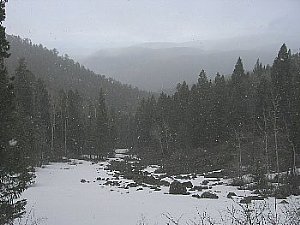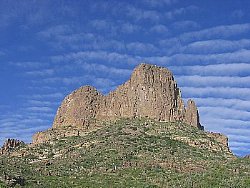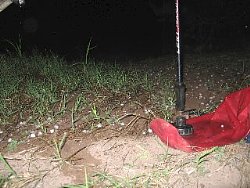Weather
Fair weather
patterns predominate in the arid Southwest. In early spring, the storm
track tends to shift north of the region, and high pressure typically
brings consecutive days of dry, mild, sunny weather. This pattern
becomes even better established by mid April, and persists throughout
May - the region's driest month on average, with little measurable
precipitation likely. By July the monsoon arrives, bringing higher
humidities and a cycle of afternoon thunderstorm activity that usually
lingers into early September. Toward the end of this month the atmosphere
typically becomes more stable and dry again, and barring any influences
from the jet stream, fair weather rules into October and November.
 |
|
Spring
flurries & old snowpack, Mogollon Mtns at 9500'
|
Storms that do
affect spring and fall thru-hikers tend to be short-lived and any
precipation tends to come in the form of rain. Temperatures at the
highest elevations can occasionally support snowfall during these
storms, but significantly accumulating snow is unlikely except perhaps
in late fall. Wind storms can occur at any time, especially during
spring in New Mexico, where gusty afternoon winds are often accompanied
by clear skies and very low humidity.
Dry air allows
for a wide range between daytime high and nighttime low temperatures.
For thru-hiking east in spring or west in fall, expect desert high
temperatures in the 70's and 80's F, with occasional 90+ degree readings
(less likely in fall), and overnight lows mainly in the 40's and 50's.
Mountain high temperatures tend to run 10 to 15 degrees cooler than
the desert. Regardless of altitude, subtract ten degrees all around
in mid to late autumn (although the lowermost Sonoran desert can remain
quite warm throughout fall).
 |
| Fair
weather cirrus & Weaver's Needle, Superstition Wilderness |
Dry air also amplifies
the sun's heat and UV, making exposed surfaces (including skin and
clothing) feel warmer than the air temperature. To an extent, though,
this heating effect is negated by the body's ability to quickly evaporate
sweat in low humidity, and exertion is often well tolerated in desert
temperatures in the 80's and even 90's. The most important consideration
in such conditions is adequate fluid and electrolyte replacement to
insure that beneficial sweating continues to occur. In addition, find
shade from time to time, wherever possible, and wear a wide-brimmed
hat and long sleeves to minimize exposure when the sun is highest.
See the Precautions section
for a few additional clothing tips.
 |
| Hail
in camp; freak spring thunderstorm on the AZ-NM border |





